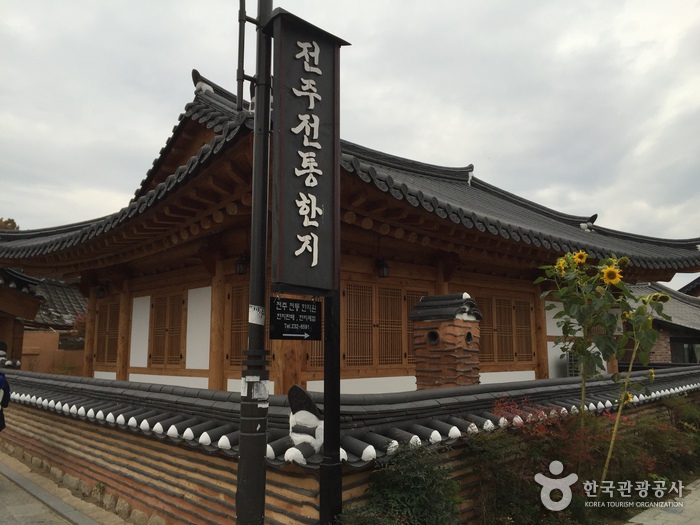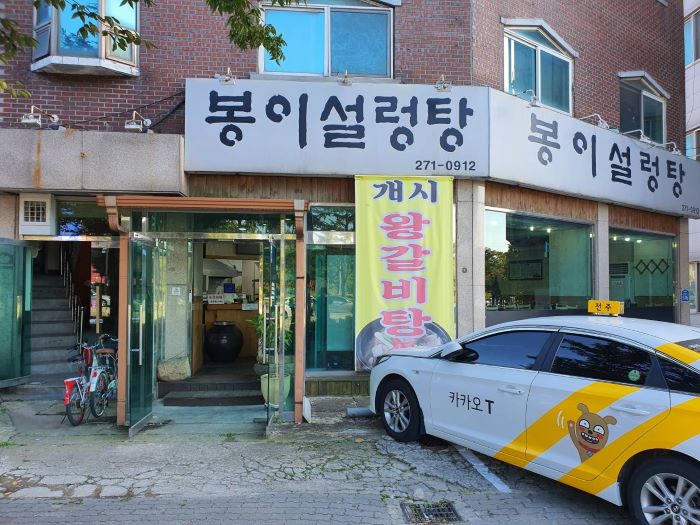Catedral Católica de Jeon-dong en Jeonju (전주전동성당)
1.7 Km 6139 2024-04-06
Taejo-ro 51, Wansan-gu, Jeonju-si, Jeonbuk-do.
La Catedral Católica de Jeon-dong fue construida en 1914 al estilo occidental y fue designada como Sitio Histórico. Es la estructura del estilo occidental más grande de las provincias de Jeollanam-do y Jeollabuk-do. La catedral es elegante con sus paredes de ladrillos y lo más encantador es la entrada y la torre de campana. La entrada de la iglesia tiene una forma arqueada que le da un toque bizantino, mientras que la pequeña torre de campana ubicada en el centro agrega una belleza singular. Desafortunadamente, algunas partes de la catedral fueron destruidas por un incendio en 1988.
Jeonju hanok house [Korea Quality] / 전주한옥숙박체험관 [한국관광 품질인증]
1.7 Km 1623 2024-04-07
56-1, Eunhaeng-ro, Wansan-gu, Jeonju-si, Jeonbuk-do
+82-10-3659-0055
Jeonjuhanok Korean House is a traditional Korean house built more than 60 years age, and it was recently remodeled for visitors to see and experience an old traditional Korean house. It’s conveniently located on the street called "Eunhaeng-ro" right in the middle of Jeonju Hanok Village for those visiting the area to take a tour of the hanok village. Although it's in the middle of the village, it's quiet inside because it's located at the end of a long, wide alley, which has the feel of an art gallery thanks to the lighting. There is a table in the yard in front of the ‘ㄱ’-shaped house. Behind the house is a café where breakfast is served. The house has an open space between the rooms called "toetmaru", which serves as a living room as in all traditional Korean houses. It’s where Koreans used to rest under the warm sunlight in the old days. The guests must pass through this "toetmaru" to get to the roms.
Jeonjuhanok Korean House has seven "ondol (floor-heated)” rooms with a loft. The rooms are clean and have a simple interior with a wooden ladder to the loft, which is a favorite place for most kids staying here with their parents. Each guestroom is furnished with a water purifier. The guesthouse serves toast, caffe Americano, fruits, and tea for breakfast.
Centro Tradicional del Hanji en Jeonju (전주전통한지원)
1.7 Km 14094 2024-04-07
Hanji-gil 100-10, Wansan-gu, Jeonju-si, Jeonbuk-do
Jeonju ha sido el mayor productor de papel tradicional hanji durante más de cien años. Aún mantiene esta orgullosa tradición y el Centro Tradicional del Hanji pretende preservar las técnicas tradicionales de fabricación de papel y ser el centro de la industria del hanji. Más del 80 por ciento del papel producido en el centro es exportado a Japón, y el resto se usa en Corea. El centro produce, expone y vende hanji para caligrafía, pinturas orientales y otros elementos artesanales.
Ihwa Gotaek [Korea Quality] / 이화고택 [한국관광 품질인증/Korea Quality]
1.7 Km 11 2024-04-07
91, Hanji-gil, Wansan-gu, Jeonju-si, Jeonbuk-do
This “ㄱ”-shaped hanok (traditional Korean house) building, standing to the right-hand side of the gate, is an old house with a history of more than 120 years that was transplanted to its present site from its original location in Buan’s local Confucian school in Jeollabuk-do. The building to the left across the courtyard is a “ㄷ”-shaped building with a history of about 70 years. The buildings at Ihwa Gotaek stick to the classics of hanok architecture, featuring the trio of open wooden-floor spaces called numaru, toenmaru, and jjongmaru.
There are 8 rooms in total, 1 four-person room with eight maximum occupancy, and 7 two-person rooms with maximum occupancy of four. All rooms have their own attached restrooms. Guests are served with complimentary seasonal refreshments, either a sweet rice punch (sikhye) or shaved ice with sweetened red beans (pat bingsu) made in-house, and for breakfast guests have a wonderful spread that includes bibimbap, rice cake soup, black sesame porridge, and bean-powder-coated rice cake, served in traditional bronze tableware. Guests can also place their reservations for traditional cultural programs like pansori (epic chant), tea ceremony, natural dye, and Korean paper art, and enjoy a discount of 30% in hanbok (traditional Korean clothes) rental.
Bongi Seolleongtang (봉이설렁탕)
1.7 Km 72 2024-04-07
576, Baekje-daero, Deokjin-gu, Jeonju-si, Jeonbuk-do
+82-63-271-0912
Seolleongtang (ox bone soup) is Korea's representative health food rich in protein. The best menu at this restaurant is ox bone soup. This Korean dishes restaurant is located in Jeonju-si, Jeollabuk-do.
GaEunChae2 [Korea Quality] / 가은채2 [한국관광 품질인증]
1.7 Km 204 2024-04-07
100-20, Hanji-gil, Wansan-gu, Jeonju-si, Jeonbuk-do
+82-10-6335-5267
Gaeunchae 2 is the sister accommodations of Gaeunchae and is located behind the Jeonju Korean Traditional Wine Museum. Completed in 2011, the traditional Hanok has soil walls and soil Ondol floors finished with traditional Hanji wallpaper and Hanji floor paper for greater traditional beauty. The exposed rafter and gray wall design make for the unique interior atmosphere of Hanok. Sculptures such as stone lantern and stone tiger in the garden, old rectangular stone, and terrace stone in the yard make the Hanok even more elegant. The small floor in the room just in front of the door is a versatile space where one can put luggage or sit and have a chat.
Being situated close to the busy Taejoro in Jeonju Hanok Village, Gaeunchae 2 offers easy access to major tourist sites of the village including Jeondong Catholic Cathedral, Gyeonggijeon, Imokdae, etc. which are within walking distance. Guests can have a food trip as well as visit great restaurants and cafes clustered nearby.
Dan Kyung [Korea Quality] / 단경 [한국관광 품질인증]
1.7 Km 230 2024-04-07
99, Hanji-gil, Wansan-gu, Jeonju-si, Jeonbuk-do
+82-10-5304-4380
Beginning of brightness that is what Hanok Guesthouse Dankyung means. The name reflects the politeness and consideration of the people of Jeonju. It also carries the wish for the guests of the guesthouse to become polite and considerate as well.
Since it was built in June 1943, Dankyung has kept its original form intact through the turbulent period of Korea's liberation from Japanese colonization, Korean War, and modernization. Despite the traditional form, the approximately 70-year-old Hanok is convenient to use and is beautiful in shape, emitting its beauty and gracefulness to the visitors of Jeonju Hanok Village. Anyone staying in Dankyung will feel as if he/she has become a noble man/woman of old Korea.
The white birch garden at the entrance, maple tree, and apricot flower tree in the yard create a seasonal atmosphere. Dansil, Hyangsil, and Gyeongsil of the main building and Byeolsil and Dasil of the separate building are equipped with a wooden floor, giving off a delicate wood scent. The gallery opposite the garden displays artworks and provides a space for guests to have breakfast or drink coffee or tea. The rooftop of the gallery is a special place for guests so that they can enjoy an uninterrupted view of Jeonju Hanok Village over drinks.
Bukyungdang [Korea Quality] / 부경당 [한국관광 품질인증]
1.7 Km 225 2024-04-07
99-5, Hanji-gil, Wansan-gu, Jeonju-si, Jeonbuk-do
+82-10-5327-8736
Located at the heart of the Jeongju Hanok Village, Bugyeongdang is a beautiful traditional 60-year old Hanok.
Traditional floor, roof tiles, and jar stands next to stone walls, while small garden and flower beds reflect the architect couple's attentive hands. As a Hanok with one of the prettiest gardens in Jeonju Hanok Village, it is a good place to appreciate the garden flowers and enjoy the unique laid-back atmosphere of Hanok while sitting on the floor. The place is close to major tourist attractions including Imokdae, Gyeonggijeon, Jeondong Catholic Cathedral, and Hyanggyo.
The owner, who was born and raised in the Jeonju Hanok Village, describes must-go sites like a tour guide and introduces undiscovered great restaurants or things-to-do to the guests. As the owner, who had long been engaged in architecture, takes care of the Hanok, the building always stays clean and in good condition.
In the shared kitchenette, guests can prepare simple breakfast for themselves with the dishes and cups made by the wife of the owner herself. Luggage storage services before check-in and after check-out, and description of tourist attractions are provided.
Jeonggahanog [Korea Quality] / 정가한옥 [한국관광 품질인증]
1.8 Km 176 2024-04-07
78-3, Girin-daero, Wansan-gu, Jeonju-si, Jeonbuk-do
+82-10-9934-1300
Jeongga Hanok is a space where the traditional beauty of hanok and the modern comfort co-exists. The newly built Hanok is neat and pleasant. When you enter the small cobbled yard, the porch and the eaves will welcome you, and you’ll find that the rooms are filled with delicate wood fragrance. The interior is furnished with Korean cypress trees and red clay. In particular, the Cypress Tree room is all made of cypress trees, from the walls to the ceiling, making guests feel like they are lying in a forest. Maple Room and Ginkgo Tree Room, meanwhile, have attics.
Jeongga Hanok faces Jeonju Hanok Village with the Girin-daero in the middle. Hanok Village is just across the road. Major attractions such as Gyeonggijeon, Jeondong Catholic Cathedral, and Jeonjuhyanggyo Confucian School are all within walkable distance. Omokdae, which offers an unhindered view of Hanok Village, is located over the pedestrian overpass. Jaman Mural Village, famous for colorful mural and cozy cafes, is about 300 meters away and a great spot for selfie lovers.
The Hanok [Korea Quality] / 더 한옥 [한국관광 품질인증]
1.8 Km 875 2024-04-07
68-15, Eunhaeng-ro, Wansan-gu, Jeonju-si, Jeonbuk-do
+82-10-2189-4002
The Hanok was transformed into a new style of hanok by combining the traditional structure (built in 1975) with a modern hanok style. Located in Jeonju Hanok Village, this large hanok is composed of a ‘ㄱ’-shaped bonchae (main building, 7-kan*), a sarangchae (men’s quarters, 3-kan), a large courtyard, and a platform for crocks of sauces and condiments. The house accepts only a limited number of people so that guests can enjoy a relaxing stay amid a pleasant, spacious environment.
Each room is built with “well-being” construction materials such as Hinoki cypress wood, red clay, and hanji (traditional Korean paper handmade from the mulberry tree). As for the four rooms of the anchae (women’s quarters), ‘Gwibin’, the largest room, is suitable for two families. It is heated with the ondol system (Korean floor heating system), and has a body massager and two king-sized beds. ‘Eoulim’ has an attic and a high ceiling with exposed rafters and crossbeams. Both rooms are equipped with two bathrooms.
The ‘ㅡ’-shaped sarangchae opposite the courtyard has three guestrooms. In particular, ‘Byeolhana’ has a red clay bed with ondol heating; while ‘Byeolset’ features a bunkbed made of wooden materials originally used in the construction of the house.
The Hanok provides a ‘Moonlight tea meeting’ where guests can enjoy tea and conversation under the moonlight in the large courtyard.
*kan - a unit of measurement referring to the distance between two columns.

![Jeonju hanok house [Korea Quality] / 전주한옥숙박체험관 [한국관광 품질인증]](http://tong.visitkorea.or.kr/cms/resource/90/2531490_image2_1.jpg)

![Ihwa Gotaek [Korea Quality] / 이화고택 [한국관광 품질인증/Korea Quality]](http://tong.visitkorea.or.kr/cms/resource/50/2707550_image2_1.jpg)

![Dan Kyung [Korea Quality] / 단경 [한국관광 품질인증]](http://tong.visitkorea.or.kr/cms/resource/65/2593265_image2_1.jpg)
![Bukyungdang [Korea Quality] / 부경당 [한국관광 품질인증]](http://tong.visitkorea.or.kr/cms/resource/29/2593529_image2_1.jpg)
![Jeonggahanog [Korea Quality] / 정가한옥 [한국관광 품질인증]](http://tong.visitkorea.or.kr/cms/resource/62/2594362_image2_1.jpg)
![The Hanok [Korea Quality] / 더 한옥 [한국관광 품질인증]](http://tong.visitkorea.or.kr/cms/resource/68/2556468_image2_1.jpg)
 Español
Español
 한국어
한국어 English
English 日本語
日本語 中文(简体)
中文(简体) Deutsch
Deutsch Français
Français Русский
Русский